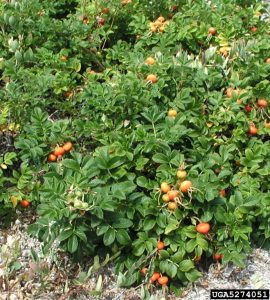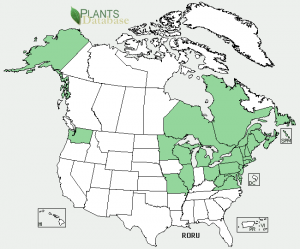Beach Rose Fact Sheet

Beach rose is a perennial, deciduous woody shrub that forms dense, multi-stemmed plants that can grow to a height of five feet. Native to Asia, it has been naturalized throughout the northeastern states, including along the Maine coast. It has been used as an ornamental in landscapes, and to provide stabilization of sand dunes. Beach rose spreads rapidly and is considered invasive in many states. It has recently been included on Maine’s Advisory List of Invasive Plants. It is included as an indicator species in Signs of the Seasons because phenology is a useful tool for understanding how native and non-native species interact and compete in changing conditions.

Leaves: Leaves are dark green and heavily veined, with serrated edges. They appear wrinkled (rugose).
Flowers: Sweet smelling flowers, two to three inches in diameter, emerge all summer long. Flowers can be white, pink or purple with yellow stamens in the center.
Stems: Stems are covered with many straight, spiny thorns.
Fruit: The orange-to-red fruits of beach rose are about 1 to 1.5 inches in diameter. These fruits, often called “hips,” can be made into teas, jams and jellies, and provide food for small animals and birds.
Sources and Additional Information:

USDA, NRCS. 2012. The PLANTS Database (http://plants.usda.gov, 20 May 2012). National Plant Data Team, Greensboro, NC 27401-4901 USA.
USA Phenology Network – Observing Plants and Animals, http://www.usanpn.org/Syringa_Vulgaris
UMaine Cooperative Extension: Maine Native Wild Blueberries, Woody Weeds, Rugosa Rose, http://umaine.edu/blueberries/factsheets/weeds/blueberry-weed-images/woody-weeds/rugosa-rose/
